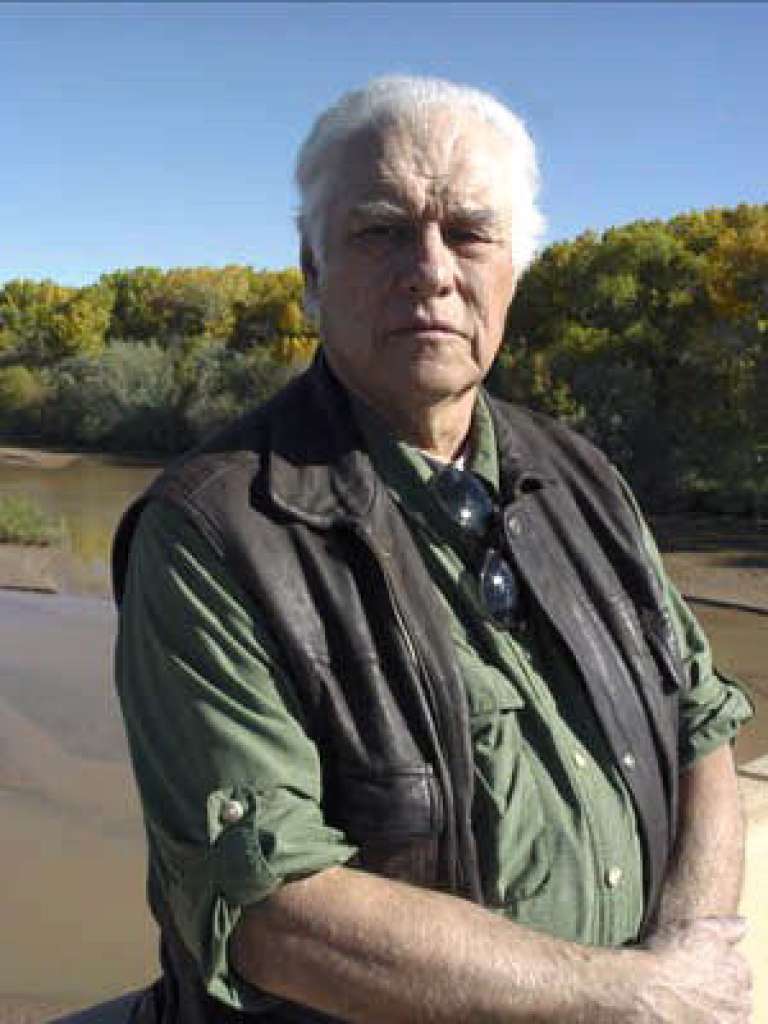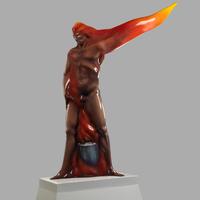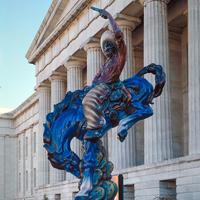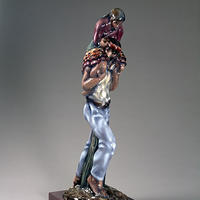More about Luis Jiménez
Works by Luis Jiménez

Contributor
Luis Jimenez was born on July 30, 1940 in the Segundo Barrio of El Paso, Texas.
Art was in the family line, from his glassblower grandfather who carried his family across the Rio Grande, to his father who made neon signs. It was in the neon shop that Jimenez would get start getting familiar with fiberglass and paint at the age of six, the same materials that would be used in his sculpture work for the rest of his life. You can also find them in lowrider cars.
Remember in “A Christmas Story” when the adults respond to the main character, “You’ll shoot your eye out” every time he wished to get a BB gun? Well, guess what happened to little ol’ Luis later on in his childhood years? Boom. For the remainder of his life he had a glass eye.
His first solo gallery showing was at the Graham Gallery in New York in 1969. Ivan Karp, director of the Leo Castelli Gallery, sent him there after Jimenez had the audacity to park his car in front and drag three of his sculptures through the front door. Guess he had enough of going through those application processes, preferring this time to just place them there himself to give a big “screw you” to any and all administration in charge.
Jimenez’s giant sculptures celebrated the Mexican heritage and working class life he was raised in, bringing Aztec myths, Catholic themes, cowboy history, and modern-day Cholo imagery into the limelight. His most famous sculpture, Man on Fire, was based on the Aztec emperor Cuauhtemoc and inspired by the self-immolation of Vietnamese Buddhist monks in response to the conflict in Vietnam. Another, Vaquero, discarded the friendly white cowboy that you’d see in a Marlboro ad in favor of a more historically true, gun-toting Mexican. Vaquero had to be moved twice due to controversy which Jimenez, the ever politically and culturally conscious, was no stranger to. At the height of his career, one of his honors had him eat dinner with George W. Bush at the White House. He showed up...in red cowboy boots. Yee-haw!
He died on June 13, 2006 after an attempt to finish one of his works, Blue Mustang, which was a way overdue commission by the city of Denver in 1992. A part of the sculpture fell off and pinned Jimenez down, severing a major artery in his leg and ensuring his death by blood loss. The piece gained the nickname "Blucifer” partially due to the incident. As if Denver International Airport wasn’t creepy enough from all the conspiracy theories and Freemason imagery, the sculpture was unveiled and made a permanent fixture on February 11, 2008.
Despite a turbulent life rife with three failed marriages and later health problems, Jimenez always did it for the barrio and the culture that ran through his veins.
Sources
- Morton, Ella. 2014. “Beware of Blucifer, the Demon Horse of Denver Airport.” Slate Magazine. Slate. March 17, 2014. http://www.slate.com/blogs/atlas_obscura/2014/03/17/the_blue_mustang_is….
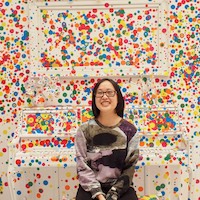
Contributor
As the “Godfather” of Chicano art, Jiménez opened the doors for Chicano culture to get into the mainstream.
If you wanted to see all of Jiménez’s works, touring the United States on a fiberglass scavenger hunt would be more in your interests than visiting all the museums that the States has to offer. Jiménez’s epic fiberglass sculptures exhibit in places all over the country.
Jiménez grew up in El Paso, Texas, where he learned the beginnings of the sculpting trade in his father’s neon-sign shop. For his BFA, he attended the University of Texas in Austin. There, he made the life-altering decision of changing his major from architecture to art, after which his father stopped talking to him for several years. Good thing art doesn’t require words, because Jiménez’s future works would often reflect his father’s experience as an undocumented immigrant.
After college, he moved to New York, where he gained success parodying 1960s American pop culture. In the 1970s, Jiménez started drawing inspiration from social realist Mexican artists like Diego Rivera and from murals commissioned by the WPA, made during the jolly years of the Great Depression. For his medium, Jiménez chose fiberglass, a material considerably less bourgeoisie than marble or aggressively masculine than bronze. As the sculptor put it, he wanted a material that lacked their “emotional baggage.”
Since immigrants (or any of us, really) can’t really relate to voluptuous marble nudes, Jiménez chose a subject a bit closer to home: the struggle of immigration itself. He flips the coin of North America onto its other side, imbuing Western archetypes with Hispanic and Native American flavor and originality. He saw what his people needed in art, and he gave it to them in full, 10-foot-tall measure.
Luis Jiménez has constructed giant Mexican cowboys, an immigrant carrying his family on his back, and a couple dancing the jarabe, or Mexican hat dance—all of whom everyone from Latinos to feminists have had issues with. Jiménez treated the criticisms like a stinky cheese, though, powering through their taste while appreciating their overall presence.
Jiménez passed away in 2006 when a piece of a 32-foot-high sculpture being moved from his studio came loose and pinned him to a steel support. The Denver International Airport had commissioned him to create a giant mustang, which—in a modern twist on Dr. Frankenstein—crushed the artist with his own creation.
Jiménez is survived by his four children and a generation of people inspired with authentic images that remind them not of a utopian, Westernized world, but of their own experiences in America.
Sources
- Marter, Joan M. The Grove encyclopedia of American art. Oxford: Oxford University Press, 2011.
- Belcher, David A. "Luis Jiménez, Sculptor, Dies in an Accident at 65." The New York Times. June 14, 2006. http://www.nytimes.com/2006/06/15/arts/design/15Jiménez.html.
- Stewart, Jocelyn Y. "Luis Jiménez Jr., 65; Artist Whose Sculptures Are on Public Display Nationwide." Los Angeles Times. June 15, 2006. http://articles.latimes.com/2006/jun/15/local/me-Jiménez15.

Sr. Contributor
Luis Jimenez was born in El Paso, Texas in 1940, just over the border from Ciudad Juarez, Mexico.
He was introduced to painting and welding at an early age when he apprenticed at the electric sign shop that his father owned. He would later earn his BFA in art and architecture at the University of Texas at Austin, then spend some time in Mexico City, where he studied Mexican muralists, including Diego Rivera. Jimenez moved to New York in 1966 and started to create sculptures using fiberglass; he had previous experience working with fiberglass from his younger days working on cars.
He returned to the Southwest in the early 1970s, where he worked at his studio in the small town of Hondo, New Mexico. Jiménez continued creating his art in fiberglass and found success with his larger than life sculptures that used bright colors. At times, he also found controversy with his art. For example, in 1983, the city of Albuquerque commissioned a piece of art for the Old Town neighborhood (a popular tourist area), specifically Tiguex Park, where it went on display.
Unfortunately, some of the residents nearby were not too happy with the sculpture, Southwest Pieta, calling it “offensive, politically incorrect and possibly blasphemous.” Some critics went so far as to say it “resembled a rape.” In order to appease the complainers, the piece would later be moved to a different park, where it was a little more out of the way, and seen by a lot fewer people. This particular sculpture is of a famous couple in Aztec lore: Popocatepetl and Ixtaccihutal, who had a sort of Romeo and Juliet tragic romance; they are also the legend behind the creation of two volcanoes in Mexico. In 1999, then First Lady Hillary Clinton, on a trip through the Southwest, visited, and then spoke in front of the Southwest Pieta; this piece would be designated a national treasure by President Bill Clinton later that same year.
This was not the first time, nor would it be the last time, Jimenez’s art would cause controversy and inspire objections to it; something similar happened with his first commissioned public work, Vaquero. That sculpture, which depicted a Hispanic cowboy on horseback firing a gun into the air, was originally installed in a park next to the City Hall of Houston in 1981, and for some reason, there were objections to it; the piece would later be moved to a more Hispanic area of town.
On June 13, 2006, Luis Jimenez was working on a 32-foot tall sculpture of a rearing horse that was commissioned by the city of Denver when a large section of the sculpture fell on him and severed the carotid artery in his leg; he was pronounced dead later that day. Even after his untimely death, there was controversy surrounding his last work of art. The sculpture, which was to be installed at the new Denver International Airport, is titled Blue Mustang, because, well, it’s blue. Jimenez’s sons eventually finished the work and it was installed at the airport in 2008. The horse also has blazing red eyes, that apparently unnerve some people as they go by the sculpture; it was nicknamed “Blucifer” and once again, there were those who wanted it removed. Fortunately for the rest of us, Denver has a five-year waiting period before their Commission on Cultural Affairs would review the possibility of removing a piece of public art. Cooler heads prevailed, so “Blucifer” is still there greeting travelers and Luis had the last laugh.
Sources
- Belcher, David A. “Luis Jimenez, Sculptor, Dies in an Accident at 65.” The New York Times. The New York Times, June 15, 2006. https://www.nytimes.com/2006/06/15/arts/design/15jimenez.html.
- Istvan, ByRachel. “Death by Art: the Untimely Death of Luis Jimenez.” DailyArtMagazine.com - Art History Stories, February 14, 2018. https://www.dailyartmagazine.com/death-art-untimely-death-luis-jimenez/.
- MacMillan, Kyle. “A Mile High and Ever Deeper: Denver’s Burgeoning Public Art Scene.” Public Art Review 20, no. 1 (Fall/Winter 2008): 58–61.
- National Archives and Records Administration. National Archives and Records Administration. Accessed April 1, 2020. https://clintonwhitehouse4.archives.gov/WH/EOP/First_Lady/html/NM_Pieta….
- Staff, ABQJournal News. “6:00am -- Adios, Luis Jimenez.” Albuquerque Journal. Accessed April 1, 2020. https://www.abqjournal.com/22757/600am-adios-luis-jimenez.html.
- “True Colors.” El Palacio. Accessed April 8, 2020. http://www.elpalacio.org/2015/06/true-colors/.
Featured Content
Here is what Wikipedia says about Luis Jiménez (sculptor)
Luis Alfonso Jiménez Jr. (July 30, 1940 – June 13, 2006) was an American sculptor and graphic artist of Mexican descent who identified as a Chicano. He was known for portraying Mexican, Southwestern, Hispanic-American, and general themes in his public commissions, some of which are site specific. The most famous of these is Blue Mustang. Jiménez died in an industrial accident during its construction. It was commissioned by the Denver International Airport and completed after his death.
His most extensive exhibition, a retrospective called Luis Jiménez: Man on Fire, which had 331 works, opened at The Albuquerque Museum in New Mexico in 1994. It was subsequently seen at the Smithsonian's National Museum of American Art in Washington, D.C.. Luis Jiménez: Working Class Heroes: Images from a Popular Culture, another large exhibition, opened at The Dallas Museum of Art in 1997, from where it traveled to other national venues.
Check out the full Wikipedia article about Luis Jiménez (sculptor)

